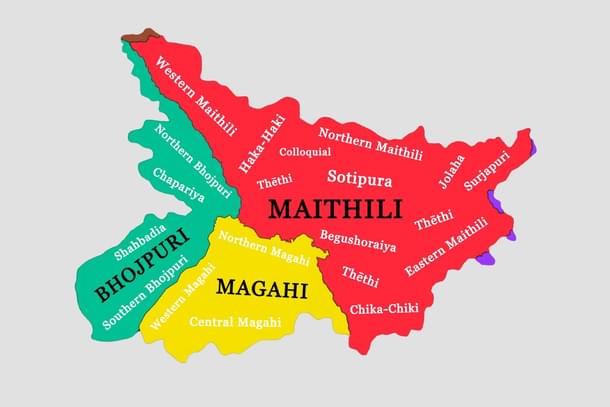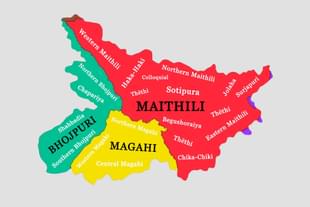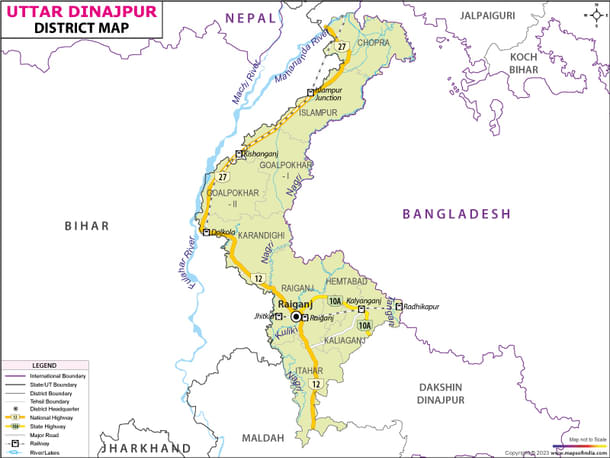Politics
Surjapuri In Trouble: Urdu Expansionism Is Slowly Killing Yet Another Native Language
Abhishek Kumar
Jan 05, 2025, 11:39 AM | Updated Feb 01, 2025, 02:28 PM IST
Save & read from anywhere!
Bookmark stories for easy access on any device or the Swarajya app.


On 30 December 2024, Kishanganj district in Bihar witnessed yet another attempt to undermine its centuries-old Surjapuri roots. Among the various subversive efforts, it was the district education officer (DEO), Naseer Hussain, who issued a controversial letter to that effect.
In his letter, Hussain highlighted that Kishanganj is a minority-dominated district but claimed that Central Board of Secondary Education (CBSE) schools were not providing Urdu education. This issue was first raised during a district development coordination and monitoring committee meeting.
Two Congress lawmakers — Ijharul Hussain, representing the Kishanganj assembly constituency, and Mohammed Jawed, representing the Kishanganj Lok Sabha constituency — brought up this concern during the meeting on 19 December 2024.
“Kishanganj is a Muslim-majority district, and students should have the opportunity to learn their community’s language. It is about ensuring equitable access to education,” stated Ijharul Hussain.
Following this, the DEO issued a letter directing CBSE schools to comply with the demand and offer Urdu education to ‘willing’ students. The letter read:
"All the private schools in Kishanganj district, recognised by the CBSE Board, are requested to ensure the necessary arrangements for the study of Urdu to the willing students and provide the relevant compliance report to the Bihar Education Project Office, Kishanganj."
Kishanganj is part of the Seemanchal region, which includes three other districts — Purnia, Katihar, and Araria. Census data reveals that these districts have a high Muslim population, with Kishanganj leading at nearly 70 per cent (according to the 2011 census).
Kishanganj lies less than 100 km from India’s Chicken’s Neck and close to Muslim-majority areas of West Bengal and Bangladesh.
Seemanchal is largely a den of parties like Congress, Rashtriya Janata Dal (RJD), and All India Majlis-E-Ittehadul Muslimeen (AIMIM). While AIMIM registered its presence in the 2020 Bihar assembly elections, Congress and RJD are having an intra-alliance fight to resurrect their Bihar campaign from this region. The Bihar leg of Rahul Gandhi’s Bharat Jodo Yatra had begun from Kishanganj, while Tejashwi was also there a few weeks ago.
The Bharatiya Janata Party (BJP) has been trying to unite Hindus here without much success under its belt. In October 2024, Union Minister Giriraj Singh reached Kishanganj for his Hindu Swabhiman Yatra, which did attract urban Hindus, but in limited numbers.
The DEO’s letter seems to reflect a heightened alertness among opposition parties following Singh’s Yatra.
The letter is problematic on many levels and has rightly drawn flak from various factions. T he DEO, a state government appointee, has no jurisdiction over CBSE schools, which are governed by the central government. Bal Mandir School Secretary Trilok Chand Jain termed the order illegal and beyond the DEO’s authority.
Dilip Jaisawal, Bihar BJP President and Minister of State for Revenue and Land Reforms, clarified that the directive was not binding, and schools would include Urdu only if they deemed it appropriate.
The move has also been criticised as an attempt at "Islamisation of education." Sushant Gope, district President of BJP in Kishanganj, stated that if Urdu is imposed, BJP would demand the recitation of the Gayatri Mantra in school prayers. He also asked the DEO to retract the order
After the statewide backlash, the DEO withdrew the directive by the end of December 2024.
The whole drama is a microcosm of the tug-of-war between those seeking to Islamicise the region and those aiming to preserve its local culture. Interestingly, the debate during the last 100 hours has largely reflected what the elite Muslim class wants, neglecting what an average Muslim in Kishanganj actually wishes for.
The Surjapuri Identity
Contrary to popular belief, Urdu is not the numero uno language of Muslims in Kishanganj. According to the 2011 census, Surjapuri is the most widely spoken language, with 42.61 per cent of the population using it. Urdu comes a distant second at 32.62 per cent, followed by Hindi, Bengali, Santhali, and Maithili.
Surjapuri is an Indo-Aryan language, genealogically related to Bengali and Maithili. It is spoken not only in Kishanganj but also in other districts of Seemanchal and nearby regions of West Bengal, such as Uttar Dinajpur.
Modern-day people (mainly Muslims) of Kishanganj holding onto this language are probably unaware that it is one of the last remaining ties to their centuries-old cultural heritage, though this connection often goes unrecognised.
The Surjapuris trace their ancestry to the Rajbanshis, a community whose name translates to "descendants of Kshatriya kings." The Rajbanshis of present-day Seemanchal, West Bengal, and Assam refer to themselves as Surjapuri Rajbanshis.
Historians have yet to determine the exact origins of the term "Surjapuri," but the prevailing theory links it to the community’s historical worship of the Sun and Moon. This theory is further supported by the presence of tribal groups in the region with similar practices.
Challenges for the Surjapuris began in the mid-11th century, when Islam started gaining a foothold in the region. By the early 13th century, Bengal had fallen under the control of Bakhtiar Khilji, bringing their traditional way of life into conflict with the new political authority.
The "convert or die" tactics employed by Islamists during this period led to widespread conversions, a trend that accelerated under Mughal rule. During Humayun's reign, Syed Khan Dastur, a Mughal official, was appointed Zamindar of Surjapur after overthrowing the Hindu ruler Sukhdeo.
This administrative change integrated Surjapur into the Tajpur Sarkar, part of the Bengal Subah under Mughal administration.
Surjapur Pargana, as it was then called, consisted of the northeastern part of the undivided Purnea district, the present-day Islampur subdivision of Uttar Dinajpur district, West Bengal, and blocks like Thakurganj, Islampur, Chopra, Kishanganj, Goalpokhar, and Karandighi, among others.

Later, Sufis arrived in the region, employing their traditional liberal methods to convert Hindus — particularly those from lower castes. Prominent figures like Syed Shah Pir Ali Chishti, who migrated from Fatehpur Sikri to Islampur, along with Adam Shaheed, Shaikh Jalal, and Kar Forma, played pivotal roles in spreading Islam.
Many of these converts, primarily from communities such as the Rajbanshis, Poliyas, Desiyas, and Kochs, became known as Nasya Shaikh, or "New Muslims." The term "Nasya," meaning "destroyed religion," symbolised their transition, while "Sheikh" was an honorific bestowed by the Sufi saints.
Despite these conversions, cultural practices remained largely unchanged. Islamic rituals were assimilated into existing traditions, allowing the Nashya Sheikh community to coexist harmoniously with Hindus for centuries.
Lewis Sydney Steward O'Malley, a British civil servant who worked in the region during the 20th century, documented this cultural synthesis.
He observed, “In the thana of Islampur in the Kishanganj Subdivision, there is only one Hindu to every two Muhammadans. Little difference can be observed between the religious beliefs of the local Hindus (including the Surjapuri Rajbanshis) and Nasya Shaikh Muslims. These New Muslims worshiped the traditional Hindu gods and goddesses alongside the Hindus. During the wedding of these Nasya Shaikh Muslims, the bride and groom visited traditional Hindu goddesses, and the bride used to apply vermilion on her forehead. New Muslims (Nasya Shaikh) practiced both Hinduism and Islam.”
The Nasya Shaikh Muslims retained several Hindu practices, such as worshipping Goddess Kali and other deities like Bishahari, belief in demonic possessions and calling Ojhas who then chanted Hindu mantras, sacrificing animals to traditional Hindu Gods and Goddesses, and praying for both Allah and Kali in shared religious spaces, among others.
A Language of the People
Speaking the Surjapuri language remained a unifying cultural thread for both communities and continues to be a shared heritage.
However, post-independence reshuffling of territorial limits and compulsions of secular polity did not allow such harmonisation. Muslim communities were increasingly isolated by Maulanas and political parties, positioning themselves as vote banks.
This dynamic shifted more dramatically after 1990, when Lalu Yadav introduced the Muslim-Yadav social equation. During this period, incidents such as driving out Hindus and desecrating temples escalated, forcing many Hindus to migrate from rural areas to cities. Temples became scarce in Kishanganj villages, though they remain present alongside mosques in towns.
Amid these transitions, demands for Surjapuri reservation gained traction. Lalu Yadav, who attended state-level functions of Surjapuri Muslims, promised and fulfilled this demand by including them in the backward classes list.
However, as with many affirmative actions, the benefits primarily reached the elite class of Surjapuri Muslims. Periodic calls to include them in the central list continue to emerge.
Demographic shifts have also influenced linguistic patterns. In villages, where Muslims form the majority, Surjapuri remains the primary language. In urban areas, while Surjapuri is spoken at home, Hindi has become the dominant public language.
Estimates suggest that over 80 per cent of Muslims in Kishanganj are of Surjapuri origin, colloquially known as "Desi Miya." The remaining Muslim population consists of Shershahbadias (Bengali Muslims who migrated to Kishanganj) and Bhatis (Bangladeshi Muslims who arrived after the 1971 war).
No matter how topsy-turvy their relationship is with Hindus, The Muslim community in Kishanganj takes pride in the Surjapuri language, challenging the stereotype of Urdu as the default language for all Muslims. A simple YouTube search for “Surjapuri language” reveals a plethora of content, from comedy sketches to romantic songs, with millions of views.
According to the 2011 census, Surjapuri is classified as a Hindi dialect, a designation its speakers contest. Though it shares some vocabulary with Hindi, it is primarily comprehensible to speakers of Maithili or Bengali.
This classification has historically been used to deny Surjapuri recognition as an independent language, often labelling it a sub-dialect of northern Bengali or a variant of Rajbanshi.
However, the language has been intrinsic to the local culture — so much so that missionaries had to translate the Bible and Testaments into Surjapuri to connect with the local population.
2011 Census figures put the Surjapuri-speaking population at 22,56,228, which is a good achievement considering the fact that big paychecks are working to replace the language with Urdu.
Bangladeshi entry into Seemanchal coincides with a period when activist circles in universities and bureaucratic institutions are searching for causes to champion. Their zeal for virtue-signaling, often framed as defending against perceived Muslim victimisation, has led to a disregard for the cultural realities on the ground.
Following the NRC in Assam, a deliberate effort has been made to unify Muslims under a singular identity by erasing regional, cultural, and linguistic differences. This narrative took time to reach Kishanganj but quickly influenced the bureaucratic mindset, including that of the DEO. Why else would he issue a letter that lacks legal standing?
However, language imposition is just one aspect of the internal frictions. The community also faces growing divisions and near-untouchability based on allegiance to Barelvi or Deobandi schools of thought. These divisions divert focus from preserving language and culture toward deepening sectarian divides.
Two years ago, the Bihar government took steps to promote Surjapuri by establishing academies. Yet, prioritising Urdu at the cost of Surjapuri amounts to nothing less than cultural imposition. For Muslims in the region, speaking Surjapuri represents the bare minimum connection to their roots.
If implemented, the Kishanganj DEO’s order could deliver a fatal institutional blow to the Surjapuri language. When a language dies, it takes the culture with it. The upcoming census may serve as a grim confirmation of this decline.
Abhishek is Staff Writer at Swarajya.





